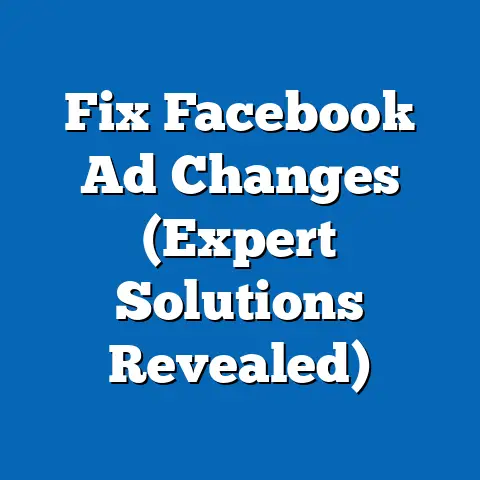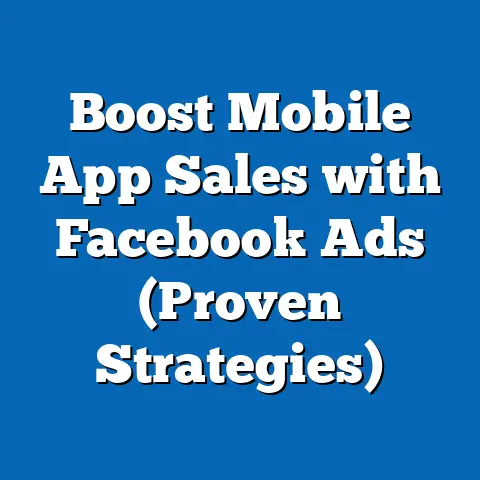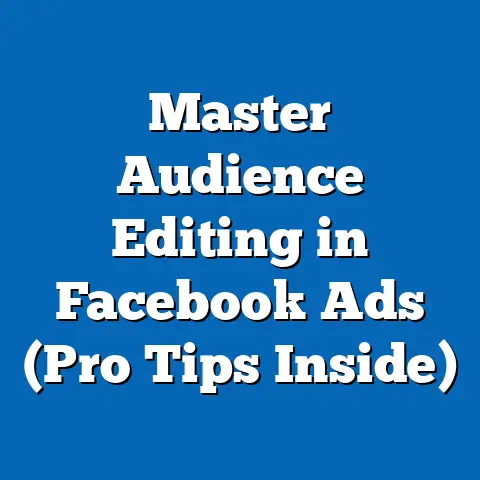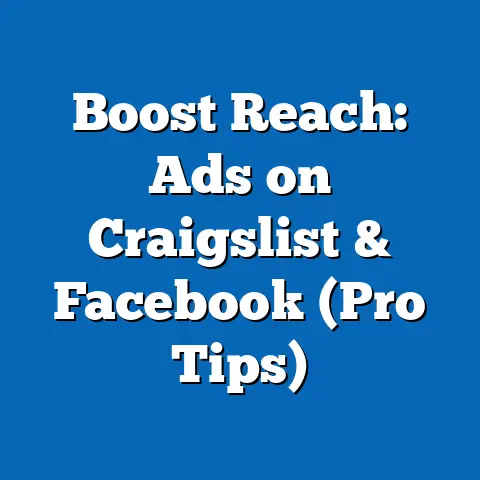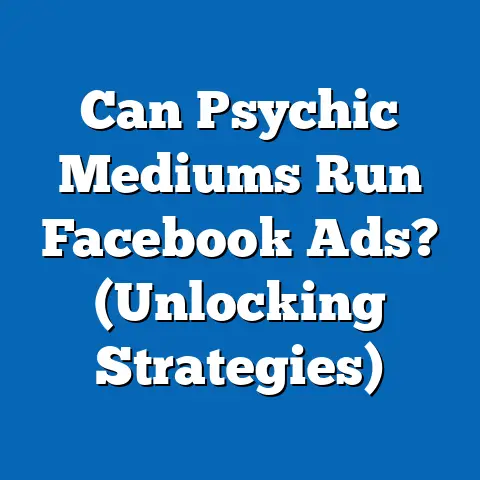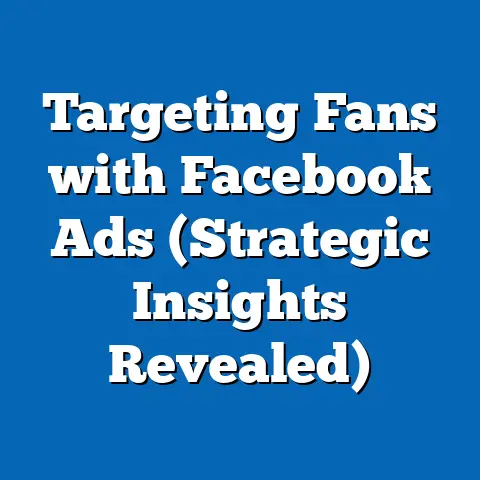Do Users Engage with Facebook Banner Ads? (Insightful Analysis)
In today’s digital age, we’re bombarded with advertisements. Scrolling through social media, browsing websites, or even checking our email, we’re constantly met with a barrage of messages vying for our attention. As a digital marketing specialist, I’ve seen firsthand how this crowded landscape makes it increasingly difficult for businesses to connect with their target audience. Facebook, with its billions of users, presents a massive opportunity for advertisers, but the key question remains: Are Facebook banner ads actually effective? Do users truly engage with them?
The answer, as with most things in marketing, isn’t a simple yes or no. User engagement with Facebook banner ads is a complex issue influenced by a multitude of factors. From the targeting strategy to the creative execution, and even the time of day the ad is shown, everything plays a role. In this article, I’ll dive deep into the world of Facebook banner ads, analyzing user engagement statistics, exploring the factors that influence ad performance, comparing them with other ad formats, and even looking at what the future holds for this often-overlooked advertising tool.
We’ll explore:
- What Facebook banner ads are and why they matter.
- Key engagement metrics and what they tell us.
- The secrets to creating banner ads that actually grab attention.
- Real-world examples of successful (and unsuccessful) campaigns.
- What the future holds for Facebook banner ads and how you can stay ahead of the curve.
Understanding Facebook Banner Ads
So, what exactly are Facebook banner ads? Unlike the more visually dynamic video or carousel ads, banner ads are static or animated images with accompanying text. They typically appear in various placements across Facebook’s platform, including the right-hand column (on desktop) and within the Facebook Audience Network, which extends your reach to other websites and apps.
Think of them as the workhorse of Facebook advertising. They’re relatively simple to create, cost-effective, and can be used to drive a variety of objectives, from website traffic to lead generation. I often use them for retargeting campaigns, showing ads to people who have already visited a website or interacted with a brand.
Facebook’s advertising platform has evolved significantly since its inception. From basic text ads to sophisticated video campaigns, the platform has constantly adapted to changing user behaviors and technological advancements. Banner ads, while perhaps not as flashy as some of the newer formats, have remained a consistent presence, providing a reliable option for advertisers looking to reach a broad audience.
The importance of banner ads lies in their versatility and scalability. They allow businesses of all sizes to participate in Facebook advertising, regardless of their budget or creative resources. Plus, with Facebook’s robust targeting capabilities, you can ensure your banner ads are seen by the right people, increasing the likelihood of engagement and conversion.
Takeaway: Facebook banner ads are a versatile and scalable advertising option that can be used to achieve a variety of marketing objectives.
Engagement Metrics for Facebook Banner Ads
Now, let’s talk numbers. How do we actually measure the effectiveness of Facebook banner ads? The key lies in understanding the various engagement metrics available in Facebook Ads Manager. Here are some of the most important ones:
- Click-Through Rate (CTR): This is the percentage of people who see your ad and actually click on it. It’s a crucial indicator of how relevant and appealing your ad is to your target audience. A higher CTR generally means your ad is resonating with users.
- Impressions: This is the number of times your ad is displayed to users. While impressions alone don’t tell the whole story, they’re important for understanding your ad’s reach and overall visibility.
- Conversion Rate: This is the percentage of people who click on your ad and then complete a desired action, such as making a purchase, filling out a form, or downloading an app. Conversion rate is the ultimate measure of your ad’s effectiveness in driving business results.
- Cost Per Click (CPC): This is the average amount you pay each time someone clicks on your ad. A lower CPC means you’re getting more bang for your buck.
- Reach: The number of unique individuals who saw your ad.
Up-to-date statistics on user engagement with Facebook banner ads can vary depending on the industry, target audience, and campaign objectives. However, industry benchmarks can provide a general idea of what to expect. For example, a good CTR for Facebook banner ads might fall between 0.3% and 1%, while a strong conversion rate could be in the 2% to 5% range. Keep in mind that these are just averages, and your own results may vary.
When comparing these metrics to other ad formats, such as video ads or carousel ads, banner ads often have lower CTRs but can also have lower CPCs. This means you might not get as many clicks, but you can reach a larger audience for the same budget. Video ads, on the other hand, tend to be more engaging but can also be more expensive to produce and run.
Takeaway: Track key engagement metrics like CTR, impressions, and conversion rates to evaluate the effectiveness of your Facebook banner ads and compare their performance to other ad formats.
Factors Influencing User Engagement with Banner Ads
What makes a Facebook banner ad successful? It’s not just about throwing up any old image and hoping for the best. Several factors can significantly impact user engagement. Here are some of the most important:
- Targeting and Audience Segmentation: This is arguably the most crucial factor. Showing your ad to the wrong people is a surefire way to waste your budget and get poor results. Facebook’s targeting options are incredibly powerful, allowing you to reach specific demographics, interests, behaviors, and even custom audiences based on your own customer data. I always emphasize the importance of understanding your target audience inside and out.
- Ad Creative Elements: The visual and textual elements of your ad are what grab people’s attention in the first place. High-quality imagery, compelling copy, and a clear call-to-action are essential. Your ad should be visually appealing, easy to understand, and relevant to your target audience. Experiment with different images, headlines, and descriptions to see what resonates best.
- Timing and Frequency of Ad Placement: When and how often your ad is shown can also impact engagement. Showing your ad too frequently can lead to ad fatigue, where users become desensitized to your message. On the other hand, not showing it enough can result in missed opportunities. Experiment with different scheduling options and frequency caps to find the sweet spot.
- Relevance: This is where personalization can make a big difference. When users see ads tailored to their interests and needs, they’re far more likely to engage. Use Facebook’s dynamic creative tools to create personalized ads that adapt to individual user preferences.
User behavior on Facebook also plays a significant role. People are often scrolling quickly through their feeds, so your ad needs to stand out and capture their attention in a split second. Understanding scrolling habits and content consumption patterns can help you design ads that are more likely to be noticed and clicked on.
Takeaway: Optimize your Facebook banner ads by carefully targeting your audience, crafting compelling creative elements, and strategically timing and frequency of ad placement.
Case Studies and Real-World Examples
Let’s look at some real-world examples to see these principles in action. I’ve been involved in countless Facebook ad campaigns, and I’ve seen firsthand what works and what doesn’t.
Example 1: A Successful E-Commerce Campaign
One of my clients, a small online clothing boutique, was struggling to drive traffic to their website. We created a series of Facebook banner ads featuring high-quality images of their latest clothing line, targeting women aged 25-45 who were interested in fashion and online shopping. The ads featured a clear call-to-action, “Shop Now,” and offered a 10% discount for first-time customers. The results were impressive: website traffic increased by 50%, and sales jumped by 20% in just a few weeks. What made this campaign successful?
- Targeted Audience: We reached the right people with the right message.
- Compelling Visuals: The images were professional and visually appealing.
- Clear Call-to-Action: The “Shop Now” button made it easy for users to take action.
- Incentive: The 10% discount provided an extra incentive for users to click and purchase.
Example 2: A Less Successful Lead Generation Campaign
Another client, a local real estate agency, wanted to generate leads for their agents. We created a series of Facebook banner ads featuring images of luxurious homes, targeting people who were interested in buying or selling property. However, the campaign failed to generate significant leads. What went wrong?
- Broad Targeting: The targeting was too broad, reaching people who weren’t actually in the market for a new home.
- Generic Message: The ads didn’t offer any specific value or address the needs of potential clients.
- Lack of Personalization: The ads were the same for everyone, regardless of their individual circumstances.
The key takeaway from these examples is that success on Facebook requires a strategic approach. It’s not enough to simply create an ad and hope for the best. You need to carefully consider your target audience, your message, and your overall campaign objectives.
Takeaway: Analyze successful and unsuccessful Facebook banner ad campaigns to identify best practices and avoid common pitfalls.
The Future of Facebook Banner Ads
What does the future hold for Facebook banner ads? As technology evolves and user behaviors change, the advertising landscape is constantly shifting. Here are some trends and predictions to keep in mind:
- Increased Personalization: Expect to see even more emphasis on personalization in the future. Facebook’s AI and machine learning capabilities will allow advertisers to create highly targeted and personalized ads that are more likely to resonate with individual users.
- Augmented Reality (AR) Integration: AR is already making its way into Facebook advertising, and it’s likely to become even more prevalent in the future. Imagine banner ads that allow users to virtually try on clothes or see how furniture would look in their homes.
- Video Banners: While currently banner ads are static, I think we will see more short-form videos being integrated into banner ad placements.
- Privacy Concerns: As privacy regulations become stricter, advertisers will need to be more transparent about how they collect and use user data. This could lead to a shift towards more privacy-friendly advertising techniques, such as contextual targeting.
- Mobile-First Approach: With the majority of Facebook users accessing the platform on their mobile devices, it’s essential to adopt a mobile-first approach to banner ad design. Make sure your ads are optimized for smaller screens and load quickly on mobile networks.
To stay ahead of the curve, it’s important to continuously experiment with new strategies and technologies. Test different ad formats, targeting options, and creative elements to see what works best for your business. Keep an eye on industry trends and adapt your approach as needed.
Takeaway: Stay informed about emerging trends and technologies in Facebook advertising to adapt your banner ad strategies for future success.
Conclusion
Do users engage with Facebook banner ads? The answer is a resounding it depends. While banner ads may not be the most glamorous or exciting ad format, they can still be a valuable tool for reaching a broad audience and driving business results. The key is to understand the factors that influence user engagement and to optimize your campaigns accordingly.
By carefully targeting your audience, crafting compelling creative elements, and strategically timing your ad placements, you can create Facebook banner ads that capture attention, drive clicks, and ultimately achieve your marketing objectives.
As the digital advertising landscape continues to evolve, it’s essential to stay informed and adapt your strategies to changing user behaviors and technological advancements. By embracing innovation and continuously experimenting with new approaches, you can unlock the full potential of Facebook banner ads and achieve lasting success on the platform.
So, the next time you’re scrolling through your Facebook feed and see a banner ad, take a moment to consider what went into creating that ad and how it might be influencing your behavior. And remember, as marketers, it’s our job to create ads that are not only effective but also respectful of the user experience. That’s the key to building lasting relationships with our customers and achieving long-term success in the ever-changing world of digital advertising.

